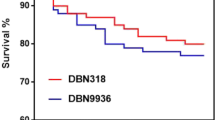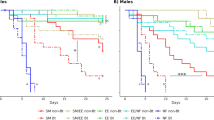Abstract
The present study investigated prey-mediated effects of two maize varieties expressing a truncated Cry1Ab, Compa CB (event Bt176) and DKC7565 (event MON810), on the biology of the ladybird Stethorus punctillum. Although immuno-assays demonstrated the presence of Cry1Ab in both prey and predator collected from commercial maize-growing fields, neither transgenic variety had any negative effects on survival of the predator, nor on the developmental time through to adulthood. Furthermore, no subsequent effects on ladybird fecundity were observed. As a prerequisite to studying the interaction of ladybird proteases with Cry1Ab, proteases were characterised using a range of natural and synthetic substrates with diagnostic inhibitors. These results demonstrated that this predator utilises both serine and cysteine proteases for digestion. In vitro studies demonstrated that T. urticae were not able to process or hydrolyze Cry1Ab, suggesting that the toxin passes through the prey to the third trophic level undegraded, thus presumably retaining its insecticidal properties. In contrast, S. punctillum was able to activate the 130 kDa protoxin into the 65 kDa fragment; a fragment of similar size was also obtained with bovine trypsin, which is known to cleave the protoxin to the active form. Thus, despite a potential hazard to the ladybird of Bt-expressing maize (since the predator was both exposed to, and able to proteolytically cleave the toxin, at least in vitro), no deleterious effects were observed.






Similar content being viewed by others
References
Al-Deeb MA, Wilde GE, Higgins RA (2001) No effect of Bacillus thuringiensis corn and Bacillus thuringiensis on the predator Orius insidiosus (Hemiptera: Anthocoridae). Environ Entomol 30:625–629
Bai YY, Jiang MX, Cheng JA (2005) Effects of transgenic cry1Ab rice pollen on fitness of Propylea japonica (Thunberg). J Pest Sci 78:123–128
Beynon RJ, Salvesen G (1989) Proteolytic enzymes : a practical approach. In: Beynon RJ, Bond JS (eds) IRL Press, Oxford, pp 241–249
Bietlot H, Carey PR, Choma C, Kaplan H, Lessard T, Pozsgay M (1989) Facile preparation and characterization of the toxin from Bacillus thuringiensis var. Kurstaki Biochem J 260:87–91
Bradford MM (1976) A rapid and sensitive method for the quantitation of microgram quantities of protein utilizing the principle of protein-dye binding. Anal Biochem 72:248–254
Carlton BC, González JM Jr (1985) Plasmid and delta-endotoxin production in different subspecies of Bacillus thuringiensis. In: Hoch JA Setlow P (eds) Molecular biology of microbial differentiation. American Society of Microbiology, Washington, DC, pp 246–252
Castañera P (1986) Plagas del Maíz. IV Jornadas Técnicas sobre el Maíz, Lérida. Plagas, 1–24
Choma CT, Surewicz WK, Carey PR, Pozsgay M, Raynor T, Kaplan H (1990) Unusual proteolysis of the protoxin and toxin from Bacillus thuringiensis. Structural implications. Eur J Biochem 189:523–527
Congdon BD, Shanks CH, Antonelli AL (1993) Population interaction between Stethorus punctum picipes (Coleoptera: Coccinellidae) and Tetranychus urticae (Acari: Tetranychidae) in red raspberries at low predator and prey densities. Environ Entomol 22:1302–1307
Cowgill SE, Atkinson HJ (2003) A sequential approach to risk assessment of transgenic plants expressing protease inhibitors: effects on nontarget herbivorous insects. Transgenic Res 12:439–449
De la Poza M, Pons X, Farinós GP, López C, Ortego F, Eizaguirre M, Castañera P, Albajes R (2005) Impact of farm-scale Bt maize on abundance of predatory arthropods in Spain. Crop Protect 24:677–684
De Maagd RA, Bravo A, Berry C, Crickmore N, Schnepf HE (2003) Structure, diversity, and evolution of protein toxins from spore-forming entomopathogenic bacteria. Annu Rev Genet 37:409–433
Díaz-Mendoza M, Pérez-Farinós G, Hernández-Crespo P, Castañera P, Ortego F (2007) Proteolytic processing of native Cry1Ab toxin by midgut extracts and purified trypsins from the Mediterranean corn borer Sesamia nonagrioides. J Insect Physiol 53:428–435
Dutton A, Klein H, Romeis J, Bigler F (2002) Uptake of Bt-toxin by herbivores feeding on transgenic maize and consequences for the predator Chrysoperla carnea. Ecol Entomol 27:441–447
EPA (Environmental Protection Agency) (2000) Bt plant pesticidas biopesticides registration action document. II Science assessment: Product Characterization. http://www.epa.ov/scipolysap/2000/october/brad2_scienceassessment.pdf
Ferry N, Raemaekers RJM, Majerus MEN, Jouanin L, Port G, Gatehouse JA, Gatehouse AMR (2003) Impact of oilseed rape expressing the insecticidal cysteine protease inhibitor oryzacystatin on the beneficial predator Harmonia axyridis (multicoloured Asian ladybeetle). Mol Ecol 12:493–504
Forcada C, E Alcacer E, Garcera MD, Martinez R (1996) Differences in the midgut proteolytic activity of two Heliothis virescens strains, one susceptible and one resistant to Bacillus thuringiensis toxins. Arch Insect Biochem Physiol 31:257–272
Gatehouse AMR, Down RE, Powell KS, Sauvion N, Rahbe´ Y, Newell CA, Merryweather A, Hamilton WDO, Gatehouse JA (1996) Transgenic potato plants with enhanced resistance to the peach–potato aphid Myzus persicae. Entomologia Experimentalis et Applicata 79:295–307
Harwood JD, Wallin WG, Obrycki JJ (2005) Uptake of Bt endotoxins by nontarget herbivores and higher order arthropod predators: molecular evidence from a transgenic corn agroecosystem. Mol Ecol 14:2815–2823
Hilbeck A, Baumgartner M, Fried PM, Bigler F (1998) Effects of transgenic Bacillus thuringiensis corn-fed prey on mortality and developmental time of immature Chrysoperla carnea (Neuroptera: Chrysopidae). Environ Entomol 27:480–487
Hull LA, Asquith D, Mowery PD (1977) The mite searching ability of Stethorus punctum within an apple orchard. Environ Entomol 6:684–688
James C (2006) Global Status of Commercialized Biotech/GM Crops. ISAAA Briefs 35. International Service for the Acquisition of Agri-Biotech Applications. Ithaca, NY
Koziel MG, Beland GL, Bowman C, Carozzi NB, Crenshaw R, Crossland L, Dawson J, Desai N, Hill M, Kadwell S, Launis K, Lewis K, Maddox D, McPherson K, Meghji MR, Merlin E, Rhodes R, Warren GW, Wright M, Evola SV (1993) Field performance of elite transgenic maize plants expressing an insecticidal protein derived from Bacillus thuringiensis. Bio/Technology 11:194–200
Lozzia GC (1999) Biodiversity and structure of ground beetle assemblages (Coleoptera carabidae) in Bt corn and its effects on non-target insects. Bollettino di Zoologia Agraria e di Bachicoltura 31:37–58
Ludy C, Lang A (2006) A 3-year field-scale monitoring of foliage-dwelling spiders (Araneae) in transgenic Bt maize fields and adjacent field margins. Biol Control 38:314–324
Lundgren JG, Wiedenmann RN (2002) Coleopteran-specific Cry3Bb toxin from transgenic corn does not affect the fitness of the non-target species, Coleomegilla maculata DeGeer (Coleoptera: Coccinellidae). Environ Entomol 31:1213–1218
McMurtry JA, Huffaker CB, van de Vrie M (1970) Ecology of Tetranychid mites and their natural enemies - Review 1. Tetranychid enemies—their biological characters and impact of spray practices. Hilgardia 40:331–386
Meissle M, Vojtech E, Poppy GM (2005) Effects of Bt maize-fed prey on the generalist predator Poecilus cupreus L. (Coleoptera: Carabidae). Transgenic Res 14:123–132
Michaud D, Cantin L, Raworth DA, Vrain TC (1996) Assessing the stability of cystatin/cysteine proteinase complexes using mildly-denaturing gelatin-polyacrylamide gel electrophoresis. Electrophoresis 17:74–79
Miranda R, Zamudio FZ, Bravo A (2001) Processing of Cry1Ab endotoxin from Bacillus thuringiensis by Manduca sexta and Spodoptera frugiperda midgut proteases: role in protoxin activation and toxin inactivation. Insect Biochem Molecular Biol 31:1155–1163
Mohan M, Gujar GT (2003) Characterization and comparison of midgut proteases of Bacillus thuringiensis susceptible and resistant diamondback moth (Plutellidae: Lepidoptera). J Invertebr Pathol 82:1–11
Murdock LL, Brookhart G, Dunn PE, Foard DE, Kelley S (1987) Cysteine digestive proteinases in Coleoptera. Comp Biochem Physiol 87B:783–787
Nisbet AJ, Billingsley PF (2000) A comparative survey of the hydrolytic enzymes of ectoparasitic and free-living mites. Int J Parasitol 30:19–27
Novillo C, Castañera P, Ortego F (1997) Characterization and distribution of chymotrypsin-like and other digestive proteases in Colorado potato beetle larvae. Arch Insect Biochem Physiol 36:181–201
Obrist LB, Dutton A, Albajes R, Bigler F (2006a) Exposure of arthropod predators to Cry1Ab toxin in Bt maize fields. Ecol Entomol 31:143–154
Obrist L, Dutton A, Romeis J, Bigler F (2006b) Biological activity of Cry1Ab toxin expressed by Bt maize following ingestion by herbivorous arthropods and exposure of the predator Chrysoperla carnea. BioControl 51(1):31–48
Oppert B (1999) Protease interactions with Bacillus thuringiensis insecticidal toxins. Arch Insect Biochem Physiol 42:1–12
Ortego F, Novillo C, Castañera P (1996) Characterization and distribution of digestive proteases of the stalk corn borer, Sesamia nonagrioides Lef. (Lepidoptera: Noctuidae). Arch Insect Biochem Physiol 33:163–180
Pilcher CD, Obrycki JJ, Rice ME, Lewis LC (1997) Preimaginal development, survival and field abundance of insect predators on transgenic Bacillus thuringiensis corn. Environ Entomol 26:446–454
Riddick EW, Barbosa P (1998) Impact of Cry3A-intoxicated Leptinotarsa decemlineata (Coleoptera: Chrysomelidae) and pollen on consumption, development, and fecundity of Coleomegilla maculata (Coleoptera: Coccinellidae). Ann Entomol Soc Am 91:303–307
Romeis J, Dutton A, Bigler F (2004) Bacillus thuringiensis toxin (Cry1Ab) has no direct effect on larvae of the green lacewing Chrysoperla carnea (Stephens) (Neuroptera: Chrysopidae). J Insect Physiol 50:175–183
Rott AS, Ponsonby DJ (2000) The effects of temperature, relative humidity and host plant on the behaviour of Stethorus punctillum as a predator of the two-spotted spider mite, Tetranychus urticae. Biocontrol 45:155–164
Roy M, Brodeur J, Cloutier C (1999) Seasonal abundance of spider mites and their predators on raspberry in Quebec, Canada. Environ Entomol 28:735–747
Rukmini V, Reddy CY, Venkateswerlu G (2000) Bacillus thuringiensis crystal δ-endotoxin: role of proteases in the conversion of protoxin to toxin. Biochimie 82:109–116
Schnepf E, Crickmore N, Van Rie J, Lereclus D, Baum J, Feitelson J, Zeigler DR, Dean DH (1998) Bacillus thuringiensis and its pesticidal crystal proteins. Microbiol Mol Biol Rev 62:775–806
Terra WR, Ferreira C (1994) Insect digestive enzymes: properties, compartmentalization and function. Comp Biochem Physiol 109B:1–62
Vaughn T, Cavato T, Brar G, Coombe T, DeGooyer T, Ford S, Groth M, Howe A, Johnson S, Kolacz K, Pilcher C, Purcell J, Romano C, English L, Pershing J (2005) A method of controlling corn rootworm feeding using a Bacillus thuringiensis protein expressed in transgenic maize. Crop Sci 45:931–938
Walker AJ, Ford L, Majerus MEN, Geoghegan IE, Birch N, Gatehouse JA, Gatehouse AMR (1998) Characterisation of the mid-gut digestive proteinase activity of the two-spot ladybird (Adalia bipunctata L.) and its sensitivity to proteinase inhibitors. Insect Biochem Mol Biol 28:173–180
Zwahlen C, Hilbeck A, Gugerli P, Nentwig W (2003) Degradation of the Cry1Ab protein within transgenic Bacillus thuringiensis corn tissue in the field. Mol Ecol 12:765–775
Acknowledgments
We are grateful to Dr. Vicente Marco (Universidad de La Rioja, Spain) for providing the colony of T. urticae; to Syngenta for providing seeds of the maize varieties Compa CB and Brasco and the Cry1Ab native protein; to Monsanto, for providing seeds of the maize varieties DKC7565 and Tietar; This work was supported by a grant from the Spanish Ministry of Environment. F. Álvarez-Alfageme was a recipient of a fellowship from the Comunidad de Madrid.
Author information
Authors and Affiliations
Corresponding author
Rights and permissions
About this article
Cite this article
Álvarez-Alfageme, F., Ferry, N., Castañera, P. et al. Prey mediated effects of Bt maize on fitness and digestive physiology of the red spider mite predator Stethorus punctillum Weise (Coleoptera: Coccinellidae). Transgenic Res 17, 943–954 (2008). https://doi.org/10.1007/s11248-008-9177-4
Received:
Accepted:
Published:
Issue Date:
DOI: https://doi.org/10.1007/s11248-008-9177-4




